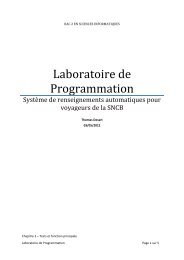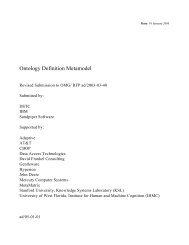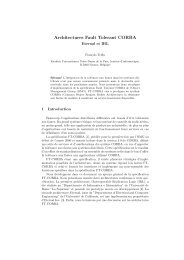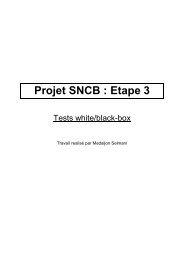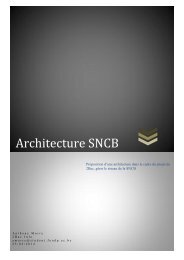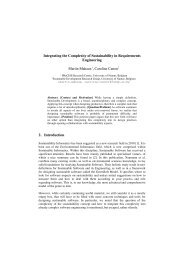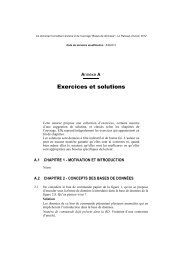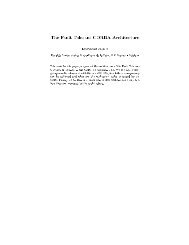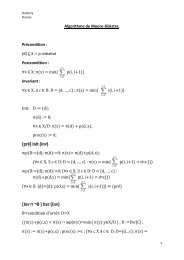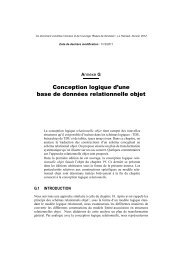Database Reverse Engineering - A Case Study - Institut d'Informatique
Database Reverse Engineering - A Case Study - Institut d'Informatique
Database Reverse Engineering - A Case Study - Institut d'Informatique
You also want an ePaper? Increase the reach of your titles
YUMPU automatically turns print PDFs into web optimized ePapers that Google loves.
Transforming this schema into relational structures is fairly easy : we disaggregate the compound attribute<br />
DESC, we express the complex relationship types passes and Purchase into entity types, then we translate<br />
the one-to-many relationship types into foreign keys. The resulting schema comprises flat entity types,<br />
identifiers and foreign keys. It can be considered as a logical relational schema (Fig. 11).<br />
ORDER<br />
CODE<br />
CUS_CODE<br />
id: CODE<br />
acc<br />
ref: CUS_CODE<br />
Details<br />
ORD_CODE<br />
STK_CODE<br />
ORD-QTY<br />
id: STK_CODE<br />
ORD_CODE<br />
ref: STK_CODE<br />
ref: ORD_CODE<br />
STOCK<br />
CODE<br />
NAME<br />
LEVEL<br />
id: CODE<br />
CUSTOMER<br />
CODE<br />
NAME<br />
ADDRESS<br />
FUNCTION<br />
REC-DATE<br />
id: CODE<br />
Purchase<br />
CUS_CODE<br />
STK_CODE<br />
TOT<br />
id: CUS_CODE<br />
STK_CODE<br />
ref: STK_CODE<br />
ref: CUS_CODE<br />
Figure 11. The relational logical schema.<br />
6.2 Physical design<br />
We reduce this phase to processing the names according to SQL standard (e.g. all the names in uppercase, no<br />
"-", no reserved words, etc) and defining the physical spaces and the access keys (indexes) which support<br />
identifiers and foreign keys (Fig. 12). As a symbolic touch of optimization, we remove all the indexes which<br />
are a prefix of another index (i.e. no index on PURCHASE.CUS_CODE and on DETAILS.ORD_CODE).<br />
ORDER<br />
ORD_CODE<br />
CUS_CODE<br />
id: ORD_CODE<br />
acc<br />
ref: CUS_CODE<br />
acc<br />
DETAILS<br />
ORD_CODE<br />
STK_CODE<br />
ORD_QTY<br />
id: STK_CODE<br />
ORD_CODE<br />
acc<br />
ref: STK_CODE<br />
acc<br />
ref: ORD_CODE<br />
STOCK<br />
STK_CODE<br />
STK_NAME<br />
LEVEL<br />
id: STK_CODE<br />
acc<br />
CUSTOMER<br />
CUS_CODE<br />
CUS_NAME<br />
ADDRESS<br />
FUNCTION<br />
REC-DATE<br />
id: CUS_CODE<br />
acc<br />
PURCHASE<br />
CUS_CODE<br />
STK_CODE<br />
TOT<br />
id: CUS_CODE<br />
STK_CODE<br />
acc<br />
ref: STK_CODE<br />
acc<br />
ref: CUS_CODE<br />
PRO_SPACE<br />
CUS_SPACE<br />
6.3 Code generation<br />
The production of the SQL code is straightforward :<br />
Figure 12. The relational physical schema<br />
FIIA96 (04/04/07) 10



